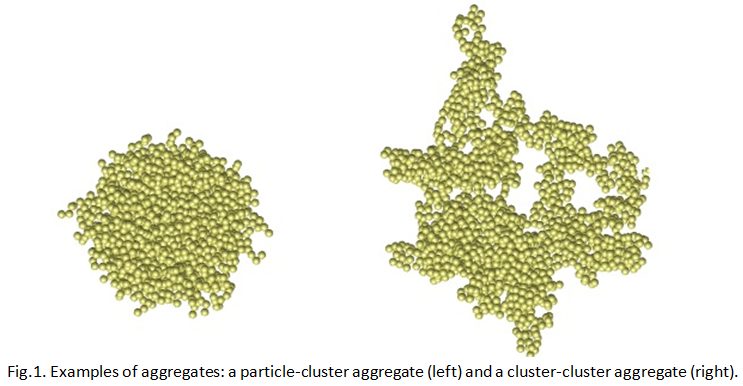- 1INAF - IAPS, Roma, Italy (ivano.bertini@uniparthenope.it)
- 2Universita degli Studi di Napoli Parthenope, Naples, Italy
- 3INAF - Osservatorio Astronomico, Trieste, Italy
The first stages of solids aggregation in the proto–solar nebula start with hit–and–stick collisions of sub–micrometer sized grains which form porous fractal aggregates with low fractal mass dimension Df < 2. Subsequent stages lead to aggregates compaction in non–fractal structures and to the appearance of the so–called bouncing barrier, increasing the impact energy between solid particles and the degree of decoupling with the surrounding gas (Blum & Wurm 2008). The outcome of dynamical simulations points to the concentration of solid material through streaming instability of the gas as the major agent followed by gravitational collapse to overcome the bouncing barrier (Goodman & Pindor 2000). Nevertheless, some of the primitive formed fractals, characterized by fractal dimension slightly lower than 2, survived the subsequent planetesimal formation and were recently found in comet 67P/Churyumov–Gerasimenko after their release from the nucleus due to cometary activity (Mannel et al. 2016; Fulle & Blum 2017).
The dynamics of fractal solids and their interaction with a surrounding gaseous medium is therefore of major interest in studying the first phases of solid aggregation in the solar system and the nature of the pristine material released by comets in space.
In the present work we study fractal clusters of monodisperse spherical monomers having two different morphologies, one extremely compact and one extremely loose. They are produced through statistical aggregation methods called particle-cluster aggregation and cluster-cluster aggregation, respectively. In the particle-cluster aggregation method a monomer, represented by a single spherical object, is used as a projectile and shot towards the center of mass of a cluster made by identical monomers (the target), sticking with it at the first contact point. No restructuring of the aggregate after the collision is taken into account. The target is therefore growing in mass at every hit and the final result is a porous object characterized by a compact overall shape. In the cluster-cluster aggregation identical cluster of monomers are colliding along a line connecting the two centers of mass, sticking at the contact point without restructuring. The final result is a porous object with a fluffy open appearance. The two processes are iterated until the desired mass is reached. The porosity and fractal mass dimension of the two kinds of aggregates increase with the number of constituent monomers and reach asymptotic values for large aggregates. Cluster-cluster aggregates (CCAs) and particle-cluster aggregates (PCAs) are characterized by porosity p~97% and p~75%, and fractal mass dimension Df~2.0 and Df~3.0 respectively, in the limit of large aggregates (Bertini et al. 2009). PCAs and CCAs resemble morphologically the classical ballistic particle-cluster aggregates (BPCAs) and ballistic cluster-cluster aggregates (BCCAs) used in dust studies in astrophysical environments (Mukai et al. 1992), respectively. Examples of the PCA and CCA structures are shown in Fig.1 with a number of monomers N = 2048, corresponding to the largest size used in our study.
Due to a probabilistic nature of the fractal aggregate model, the generated fractal objects are not identical (even constructed with the same number of monomers). We derive statistics on the geometrical (e.g. cross-sections) and dynamical properties (e.g. moments of inertia) of the fractal objects.
Assuming the dust particles are submitted in a gas flow of a simplified model of a cometary coma (Ivanovski et al. 2017), we derive asymptotic mean and dispersion in the translational and rotational motion of dust.

References:
Bertini, I., Gutierrez, P. J., & Sabolo, W. 2009, A&A, 504, 625
Blum, J. & Wurm, G. 2008, ARA&A, 46, 21
Fulle, M. & Blum, J. 2017, MNRAS, 469, S39
Goodman, J. & Pindor, B. 2000, Icarus, 148, 537
Ivanovski, S.L., Zakharov, V.V., Della Corte, V., Crifo, J-F., Rotundi, A., Fulle, M. 2017, Icarus 282, 333-350
Mannel, T., Bentley, M. S., Schmied, R., et al. 2016, MNRAS, 462, S304
Mukai, T., Ishimoto, H., Kozasa, T., Blum, J., & Greenberg, J. M. 1992, A&A, 262, 315
How to cite: Bertini, I., Zakharov, V., Ivanovski, S., Petropoulou, V., Della Corte, V., and Rotundi, A.: Dynamical properties of a fractal dust, Europlanet Science Congress 2021, online, 13–24 Sep 2021, EPSC2021-633, https://doi.org/10.5194/epsc2021-633, 2021.

